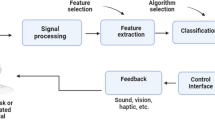Abstract
Near-infrared spectroscopy (NIRS) was used to assess human motor-cortex oxygenation changes in response to cyclic coupled movements of hand and foot. Using a highly sensitive NIRS instrument, we showed that it was possible to detect reproducible oxygenation patterns using single cycles (20 s) of easy and difficult association tasks. No significant differences in the time corresponding to the maximal changes in concentration of oxy- and deoxyhemoglobin ([O2Hb] and [HHb], respectively) were found during easy and difficult association as well as cycles. Only [O2Hb] showed a significantly higher value at the end of the difficult association during the first cycle. No significant differences were found for [O2Hb] and [HHb] in the other cycles. We conclude that NIRS is a useful addition to functional magnetic resonance imaging in investigating the time course of cortical activation.
Similar content being viewed by others
Author information
Authors and Affiliations
Additional information
Received: 9 October 1998 / Accepted: 13 August 1999
Rights and permissions
About this article
Cite this article
Colier, W., Quaresima, V., Oeseburg, B. et al. Human motor-cortex oxygenation changes induced by cyclic coupled movements of hand and foot. Exp Brain Res 129, 457–461 (1999). https://doi.org/10.1007/s002210050913
Issue Date:
DOI: https://doi.org/10.1007/s002210050913




